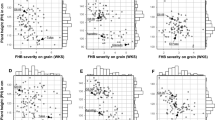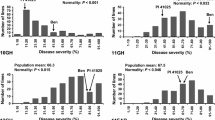Abstract
Resistance to Fusarium head blight (FHB) caused by Fusarium graminearum Schwabe in wheat (Triticum aestivum L.) was identified in disomic chromosome substitution and translocation lines, into which chromosome 7el2 had been introgressed from wheatgrass, Thinopyrum ponticum. In this study, two chromosome substitution lines with different origins (designated as el1 and el2) and with different reactions to infection by F. graminearum were crossed to develop a segregating mapping population. The objectives of this study were to determine the effectiveness of this type II resistance and map it on chromosome 7el2. Type II resistance to FHB was characterized in the F2, F2:3 families, F4:5 plants and F5:6 recombinant inbred lines developed by single-seed descent; and the population was characterized in the F2 and F5 with DNA markers along the long arm of 7el. Composite interval mapping revealed a FHB resistance QTL, designated Qfhs.pur-7EL, located in the distal region of the long arm of 7el2 and delimited with flanking markers XBE445653 and Xcfa2240. Additive effects of Qfhs.pur-7EL reduced the number of diseased spikelets per spike following inoculation of one floret in four experiments by 1.5–2.6 and explained 15.1–32.5% of the phenotypic variation in the populations. Several STS-derived and EST-derived PCR or CAPS markers were developed in this chromosomal region, and showed the specificity of 7el2 compared to an array of wheat lines possessing other sources of FHB resistance. These markers are useful in an effort to shorten the chromosome segment of 7el2 and to use for marker-assisted introgression of this resistance into wheat.




Similar content being viewed by others
References
Chen P, Liu W, Yuan J, Wang X, Zhou B, Wang S, Zhang S, Feng Y, Yang B, Liu G, Liu D, Qi L, Zhang P, Friebe B, Gill BS (2005) Development and characterization of wheat-Leymus racemosus translocation lines with resistance to Fusarium Head Blight. Theor Appl Genet 111:941–948
Dvorak J (1975) Meiotic pairing between single chromosomes of diploid agropyron elongatum and decaploid A. elongatim in Triticum aestivum. Can J Genet Cytol 17:329–336
Gupta P, Balyan H, Edwards K, Isaac P, Korzun V, Röder M, Gautier M-F, Joudrier P, Schlatter A, Dubcovsky J, De la Pena R, Khairallah M, Penner G, Hayden M, Sharp P, Keller B, Wang R, Hardouin J, Jack P, Leroy P (2002) Genetic mapping of 66 new microsatellite (SSR) loci in bread wheat. Theor Appl Genet 105:413–422
Hossain KG, Kalavacharla V, Lazo GR, Hegstad J, Wentz MJ, Kianian PMA, Simons K, Gehlhar S, Rust JL, Syamala RR, Obeori K, Bhamidimarri S, Karunadharma P, Chao S, Anderson OD, Qi LL, Echalier B, Gill BS, Linkiewicz AM, Ratnasiri A, Dubcovsky J, Akhunov ED, Dvořák J, Miftahudin Ross K, Gustafson JP, Sidhu D, Dilbirligi M, Gill KS, Peng JH, Lapitan NLV, Greene RA, Bermudez-Kandianis CE, Sorrells ME, Feril O, Pathan MS, Nguyen HT, Gonzalez-Hernandez JL, Wennerlind EJ, Anderson JA, Fenton D, Close TJ, McGuire PE, Qualset CO, Kianian SF (2004) A chromosome bin map of 2148 EST loci of wheat homeologous group 7. Genetics 168:687–699
Khan IA (2000) Molecular and agronomic characterization of wheat-Agropyron intermedium recombinant chromosomes. Plant Breeding 119:25–29
Kim NS, Armstrong K, Knott DR (1993) Molecular detection of Lophopyrum chromatin in wheat-Lophopyrum recombinants and their use in the physical mapping of chromosome 7D. Theor Appl Genet 85:561–567
Kim W, Johnson W, Baenziger PS, Lukaszewski AJ, Gaines CS (2004) Agronomic effect of wheat-rye translocation carrying rye chromatin (1R) from different sources. Crop Sci 44:1254–1258
Larkin PJ, Kleven S, Banks PM (2002) Utilizing Bdv2, the Thinopyrum intermedium source of BYDV resistance, to develop wheat cultivars. In: Henry M, McNab A (eds) Barley yellow dwarf disease: recent advances and future strategies. Mexico, D.F. CIMMYT, pp 60–63
McIntosh RA, Hart GE, Devos KM, Gale MD, Rogers WJ (1998) Catalogue of gene symbols for wheat. In: Slinkard AE (ed) 9th international wheat genetics symposium, Saskatoon. 2–7 Aug. 1998. University Extension Press, University of Saskatchewan, Saskatoon, Saskatchewan, Canada
Ohm H, Anderson J (2005) Utilization and performance in wheat of yellow dwarf virus resistance transferred from Thinopyrum intermedium. In: Proceedings of 7th international wheat conference. November 27–December 2, 2005. Mar del Plata, Argentina. SAGPyA and INTA, Argentina, p 20
Oliver RE, Cai X, Xu SS, Chen X, Stack R (2005) Wheat-alien species derivatives: a novel source of resistance to Fusarium head blight in wheat. Crop Sci 45:1353–1360
Shen X, Kong L, Ohm H (2004) Fusarium head blight resistance in hexaploid wheat (Triticum aestivum)-Lophopyrum genetic lines and tagging of the alien chromatin by PCR markers. Theor ApplGenet 108:808–813
Shen X, Ohm H (2006) Fusarium head blight resistance derived from Lophopyrum elongatum chromosome 7E and its augmentation with Fhb1 in wheat. Plant Breeding 125:424–429
Somers DJ, Isaac P, Edwards K (2004) A high-density microsatellite consensus map for bread wheat (Triticum aestivum L.). Theor Appl Genet 109:1105–1114
Sourdille P, Singh S, Cadalen T, Brown-Guedira GL, Gay G, Qi L, Gill BS, Dufour P, Murigneux A, Bernard M (2004) Microsatellite-based deletion bin system for the establishment of genetic-physical map relationships in wheat (Triticum aestivum L.). Funct Integr Genomics 4:12–25
Weng YQ, Wu LF, Chen PD, Liu DJ (1993) Development of alien addition lines of wheat scab resistance from Roegneria kamoji C. Koch. In: Li ZS, Xin ZY (eds) Proceedings of the 8th international wheat genetics symposium (Beijing, China). China Agric. Sci. Press, Beijing, pp 365–368
Acknowledgements
This research was supported by the US Department of Agriculture, under Agreement No. 59-0790-9-057 through the US Wheat & Barley Scab Initiative. However, any opinions, findings, conclusions, or recommendations expressed in this publication are those of the author(s) and do not necessarily reflect the view of the US Department of Agriculture.
Author information
Authors and Affiliations
Corresponding author
Rights and permissions
About this article
Cite this article
Shen, X., Ohm, H. Molecular mapping of Thinopyrum-derived Fusarium head blight resistance in common wheat. Mol Breeding 20, 131–140 (2007). https://doi.org/10.1007/s11032-007-9079-9
Received:
Accepted:
Published:
Issue Date:
DOI: https://doi.org/10.1007/s11032-007-9079-9




